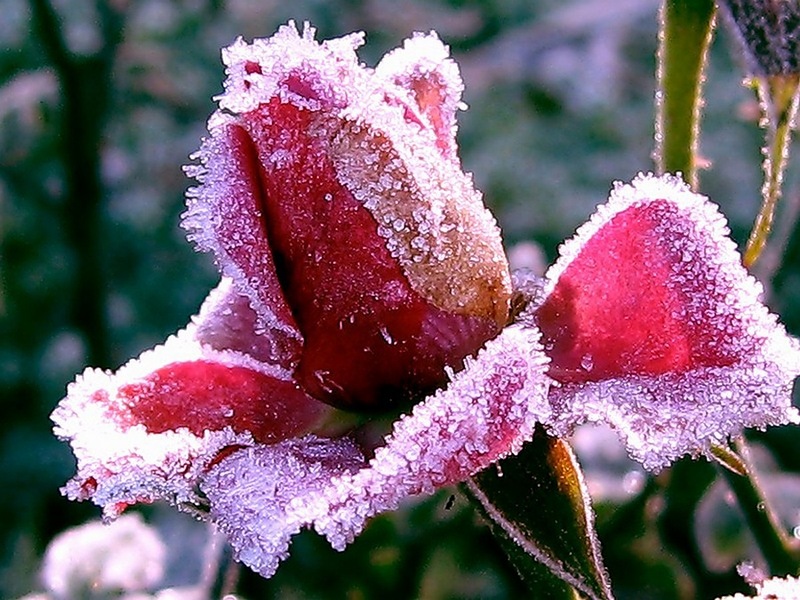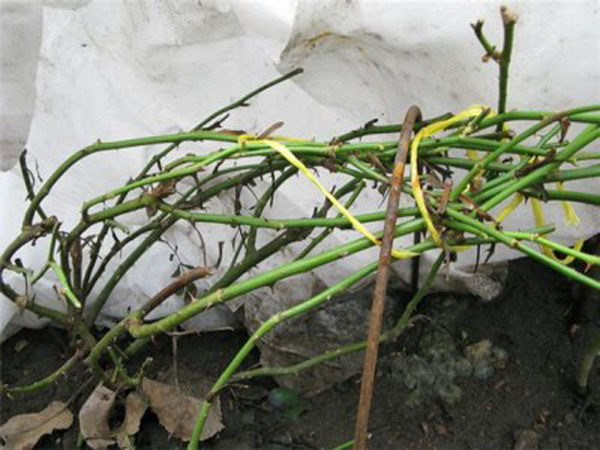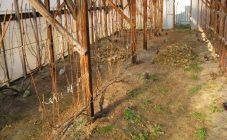Content:
On the eve of winter, rose bushes are fed with fertilizers that increase resistance to cold. But for plants wintering in the open field, this is not enough. How to cover roses for the winter so that frost does not damage the root system and shoots? This question is relevant for owners of rose gardens living in the suburbs, central Russia, the Urals, territories with severe winters.
Preparing roses for winter
In autumn, the main goal is to slow down the growing season. For this reason, already in August, the roses are no longer fed with nitrogen fertilizers that stimulate growth, and are switched to phosphate-potassium. In September, the bushes cease to be cut, only weak, diseased shoots are removed. Loosening the soil around the plants is also not recommended.
Watering roses in the fall should be very moderate, and if it rains constantly, then you can stretch plastic wrap over the bushes and dig small grooves nearby to drain the water.
Is it necessary to cover
The ability to tolerate frost is primarily influenced by the variety of roses and specific weather conditions, and insignificantly - by the age and condition of the plant. Park roses, species (aka rose hips), absolutely frost-resistant (John Davis, Hansa, Skabroza, etc.), some hybrid varieties are distinguished by high winter hardiness. But this does not mean that flowers do not need autumn care before wintering. Obligatory care for winter-hardy varieties:
- sprinkle the base of the bushes with earth;
- pruning by removing dry shoots;
- shape the bush so that the stems do not break under the weight of the snow.
If the winter is mild and snowy, roses, varieties of which are not winter-hardy, can overwinter without shelter. In all other cases, shelter for rose bushes is necessary.
What to cover
Usually, any materials at hand are used: wire, boards, foliage, earth, spruce branches, old blankets, bags, plastic wrap, etc. Covering material can be bought at the store. Often, gardeners choose geotextiles or spandbond.
The choice of covering material depends on the type of cover. If the plants are large, healthy, belong to varieties with good winter hardiness, then the bushes can simply be bent to the ground and covered with spruce branches. If the plants are weakened or do not have good immunity, then you will have to build something like a house made of wire, plywood, boards and burlap or polyethylene.
How to properly cover roses for the winter
The type of shelter for roses is dictated by the varietal and species characteristics of the flower.
If the rose is climbing
Before constructing a winter house, the flower is looked after:
- pinch the shoots;
- remove leaves;
- the whips are removed from the supports;
- inspect the plant and, if there is damage, sprinkle the slices with charcoal.
Then go directly to the shelter. To create it, there are 2 options: a method with sprinkling the base of a bush with earth and an option with a shield cover.
The procedure for creating a comfortable shelter using the ground:
- Sprinkle the base of the bush with earth, cover the top with a layer of needles, sprinkle with sand. Place spruce branches on top.
- Lay the whips on the spruce branches and cover them on top with spruce branches.
- Wrap the shoots with spruce branches lying above and below in a film.
In order for the flower to winter in comfortable conditions, a real winter house is created for it:
- Scourges are collected in a tourniquet.
- Heavy, thick stems tilt to the ground, but do not allow contact with the ground. A frame made of wire, wood is placed in the gap.
- When the climbing rose is laid, a wooden shield is placed over it.
- The entire structure is covered with a film, taking care that all walls and joints are under cover.
Bush roses
With the first frost, the bushes are pruned in autumn - young soft shoots and leaves are removed, the stems are cut, leaving 30-40 cm. The plant is treated with a fungicide (Inta-Vir).
To keep the roses in the cold, a shelter is being built:
- A hut is set up over the bushes made of scrap materials. For side panels, wooden blanks, metal corners, metal profiles are used. On top of the panels, a film, spunbond is fixed.
- In regions with warm winters, covering is limited to hilling the base of the bush with soil (mulch). From above, the bushes need to be insulated with spruce branches.
- In varietal roses, which are especially treasured, the stems are completely cut off or laid on the ground with fixing the position with brackets. Then the bush is insulated with needles, dry leaves, spruce branches. Pegs are driven in around the slide of covering materials for roses, a strip of insulation is laid on them. The whole structure is covered with a film or spunbond. The edges of the material are pressed down with stones, which is convenient for periodical ventilation of the shelter.
Standard grades
In preparation for warming, standard roses are subjected to only light sanitary pruning - the bush is almost not pruned.
You can warm flowers in different ways.
Young bushes are tilted to the ground, and the position is fixed with metal braces. The base of the plant is abundantly covered with needles, leaves, sand. The top of the stem from above and below is enclosed in spruce branches and wrapped in spunbond film.
A wire frame is placed on bushes with a stiff stem, or pegs are placed around the bush. Polyethylene is thrown onto the structure, the inner space is filled with spruce needles, dry leaves, sawdust, and the covering material is pulled together with twine.
Covering roses using the Minnesota method alone will not work. First, soil is removed from one side of the bush, and the plant is tilted in this direction. When the hand of one person bends the trunk, the partner pries the rhizome, helping him to wriggle out of the ground. The position of the bush lying on the ground is fixed with hairpins. The inverted rhizome, trunk, crown are covered with needles, sand, spruce branches.
Homemade roses growing in a tub should be stored in a dry, cold basement in winter.
Winter shelter for park varieties
Park roses are frost-resistant, but it is better to play it safe and cover the plants for the winter. Especially in areas with harsh winters. Autumn pruning for roses consists in removing old and diseased shoots, shortening one-year-olds by 5-10 cm.From August, loosening of the earth and watering stops, until frost the plant is spud up to a height of 20 cm with peat and earth. The flower is covered with a film, the ground at the base is covered with spruce branches, pressing the edges of the covering material. For shelter, a dry method is also suitable with the installation of a winter house for roses from shields, which are covered with plastic wrap.
How to shelter floribundas for the winter
Autumn pruning is a prerequisite for preparing floribunda roses for wintering.The bushes are cut so that the height of the stems above the ground is no more than 30 cm.
From the parent, a polyanthus rose, the hybrid inherited frost resistance, and in order to preserve the floribunda bushes in the open field, it is enough to cover the base of the bush with earth or peat for the winter.
Features of preparing roses for wintering in the Moscow region, Siberia, in the Urals
There are few differences, since it basically all depends on the variety and condition of the plants. In the Moscow region, winters are often not very frosty and snowy, so a cover of spruce branches is enough for most types of roses. But in the Urals and Siberia, the land can freeze up to 1.5 meters in winter, so even for sufficiently frost-resistant varieties, it is better to build a house out of boards or plywood.
There is another danger in Siberia: when there is a lot of snow, the plants can grow out if the shelter is too dense. Therefore, in this region, you need to more carefully approach the choice of materials: abandon linoleum, roofing material, etc.
To make the garden with the rose garden more beautiful from year to year, the rose bushes need care. Its important stage is the preservation of flowers in winter bad weather.
















